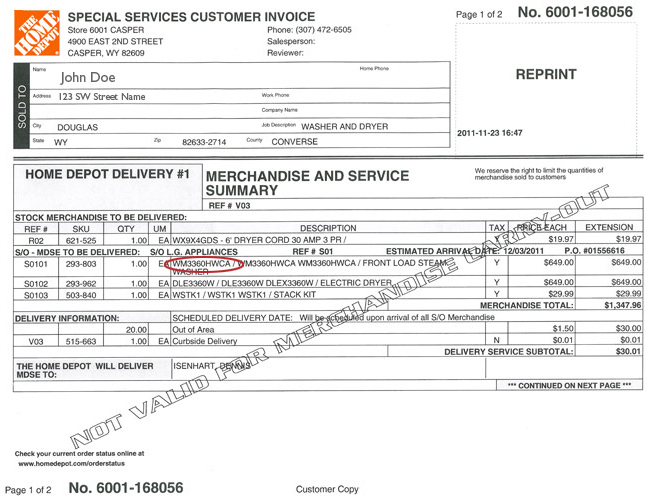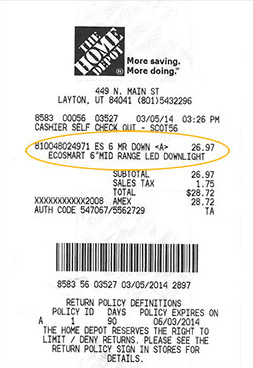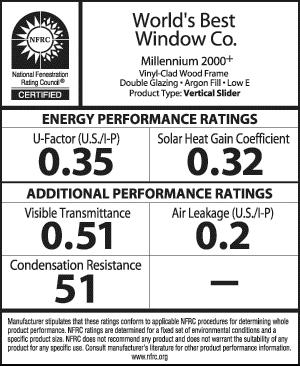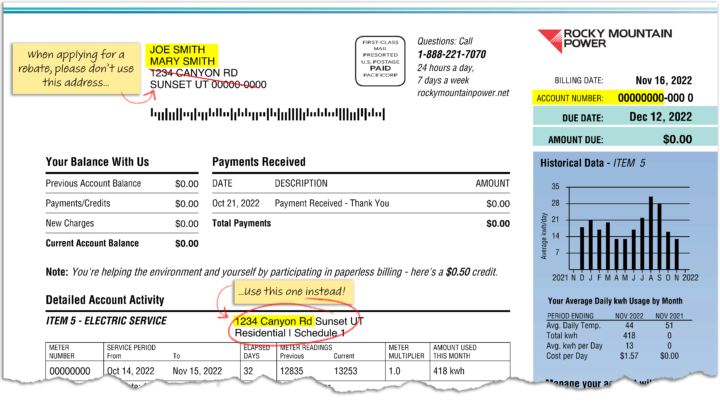No matter where you are in the home improvement process, we’re always happy to help. Please review our FAQs and feel free to contact us for further assistance.
Already applied for an online rebate? Check your application status
All rebates require you to fill out the application completely and attach your itemized invoice and/or receipt. Each type of application has its own documentation requirements. Please review the instructions on the application to find the required documentation for your incentive.
Please keep proof of your application submission for your records. Proof of submission includes tracking information if you mail your application or a copy of the submission confirmation if you apply online. The program is not responsible for applications lost in the submittal process online or through the mail; however, we may be able to process an incentive request if you have proof of submission.
For certain products, such as clothes washers, Home Depot register receipts do not include model numbers. The Special Services Customer Invoice does, which allows us to process your application in a timely manner. If you have misplaced your customer invoice you can contact Home Depot with the customer agreement number from your register receipt and they will print a new one for you.


An NFRC sticker is a sticker on each window that details the energy performance ratings for windows. Often each pane of each window will have one. In order to receive an incentive, an NFRC sticker or a copy of each must be provided for each window. Manufacturer’s specification sheets are also acceptable if stickers cannot be submitted. Here is an example of an NFRC sticker:

R-value is a measurement of how much warm or cool air (depending on the season) your insulation keeps inside your home. If you don’t know how to measure R-value we recommend you ask your contractor for help determining the existing R-value of your insulation. You can also try using our Insulation Calculator.
Your home may be selected for a random inspection to verify the information on the application and ensure proper installation. Applications will not be processed until the inspection is complete.
If you are chosen for inspection, the inspector will call you to make an appointment. An inspection on average takes 20-30 minutes but can go longer if the work was not completed to program requirements. The inspector will contact the contractor if the work was not completed to program requirements.
Your account number can be found on your utility statement (example shown below). If you do not have your account number you can call our billing department at 1-888-221-7070.

We use your account number to verify the service address and the name on the account. Please note that we must issue the rebate to the account holder for the installation address. In order to qualify for incentives, the address where your item is installed must be served by Rocky Mountain Power on a residential rate schedule.
Qualified Rate Schedules:
Yes. Each state has different requirements.
The easiest way to find out if your product qualifies is to look up the model number on our qualified products list or review the product qualifications. Just visit the incentives section of our site to find the appropriate page with product listings and details for your specific upgrade.
The Wattsmart Homes program uses this information to capture data about just how much electricity your home improvement project will save. These questions are required, so please fill them out. If you miss one it could lead to a delay in processing your application.
This means that the heating fuel source for at least 80 percent of your home must be electric (e.g. baseboard heaters or an electric furnace) or at least 80 percent of your home must be cooled by a centrally ducted cooling system (air conditioner or an electric heat pump).
Unfortunately, you would not qualify. The only qualified cooling systems are centrally ducted air conditioners and electric heat pumps.
No. The fuel that creates the heat must be electric in order to qualify as electric heat.
Most household water heaters are either gas or electric. Look at the heater and see how many pipes go into the heater. If there are three one-inch diameter pipes and an electric plug, it is electric. You’ll also see a reset switch. If there are three one-inch diameter pipes in the top and one small one at the bottom with a valve to turn on/off, it is gas.
No. Air source heat pumps transfer heat from the outside of a building to the inside, or vice versa. This is different than how furnaces operate.
They are different. An electric air source heat pump (ASHP) transfers heat from the outside of a building to the inside, or vice versa. Swamp coolers and evaporative coolers cool the air by blowing it over water.
Funding for Wattsmart programs comes from a small charge on customer bills. In the short term, these programs can help customers save on monthly utility bills and boost home performance. In the long term, they work to keep everyone’s costs down and meet the region’s growing energy needs.
Customer rebates are paid directly to the name on the utility account unless otherwise specified. Some products have both a customer and contractor rebate. Contractor rebates are paid to the contractor listed on the application and W-9.
Setting up a landlord account is an option. This is an account that exists in the background behind the tenant’s account. For more information on setting one up, contact us at 1-888-221-7070.
If you applied online, you can quickly check the status of your application by using the online application portal. If you applied by mail, contact us by email with your name and account number.
Applications are reviewed within five business days from submittal and payments are sent promptly following approval. We’ll contact you if we need more information to complete your application.
Your rebate payment will be delivered through a platform called Recipient Select. This platform gives you the power to choose how you would like to receive a payment. A variety of payment choices are available to suit your needs.
Paypal, Pay to Card, Bank Transfer, Zelle, or Check
For a list of Qualified Contractors in your area, visit our find a contractor page.
Yes. Your contractor should provide this information unless the product was self-installed. If the product was self-installed, the box can be left empty.
The National Fenestration Rating Council (NFRC) is a 501(c)3, nonprofit organization that provides performance ratings on windows, doors and skylights. NFRC administers a certification and labeling program overseeing energy efficiency of windows, doors and skylights.
Seasonal Energy Efficiency Ratio, an equipment efficiency rating that measures how much energy it takes to cool the air. It measures how efficiently a cooling system will operate over an entire season. The higher the SEER, the more efficient the air conditioner.
Home Energy Savings is under Rocky Mountain Power’s Wattsmart Homes program which offers incentives and services for residential energy efficiency projects.
R-value of insulation is a measurement of the insulation’s ability to resist heat traveling through it. The higher the R-value, the more effective your insulation is at regulating the temperature inside your home.
Water Factor, or WF, is the water performance metric that allows the comparison of clothes washer water consumption independent of clothes washer capacity. The lower the value, the more water efficient the clothes washer is. To find your clothes washer’s WF, go to the ENERGY STAR® website.
Solar Heat Gain Coefficient is the fraction of solar radiation admitted through a window. This tells you how well the product blocks heat caused from the sun. The lower the SHGC, the less solar heat it admits into your home.
U-Factor measures the heat transfer through a window and lets you know how well the product insulates. The lower the U-Factor, the greater resistance to heat flow (in and out) and the better its insulation value.
Modified Energy Factor, or MEF, is a calculation used to compare the relative efficiency of different clothes washers. The higher the value, the more efficient the clothes washer. To find your clothes washer’s MEF, go to the ENERGY STAR® website.
Heating Seasonal Performance Factor is an equipment efficiency rating. HSPF is a measure of a heat pump’s energy efficiency over one heating season. It represents the total heating output of a heat pump (including supplementary back-up electric heat) during the normal heating season.
Energy Factor, or EF, is the energy performance metric used for electric water heaters. The higher the EF, the more efficient the electric water heater. To look up your electric water heater’s EF, visit the ENERGY STAR® website.
A device that uses a small amount of energy to heat your home. Unlike gas furnaces, they also have the ability to provide cooling when needed.